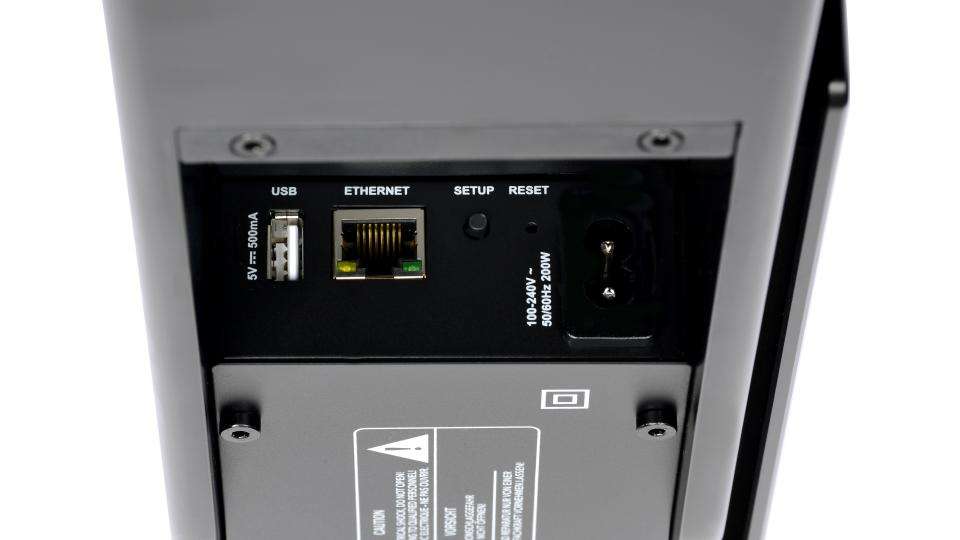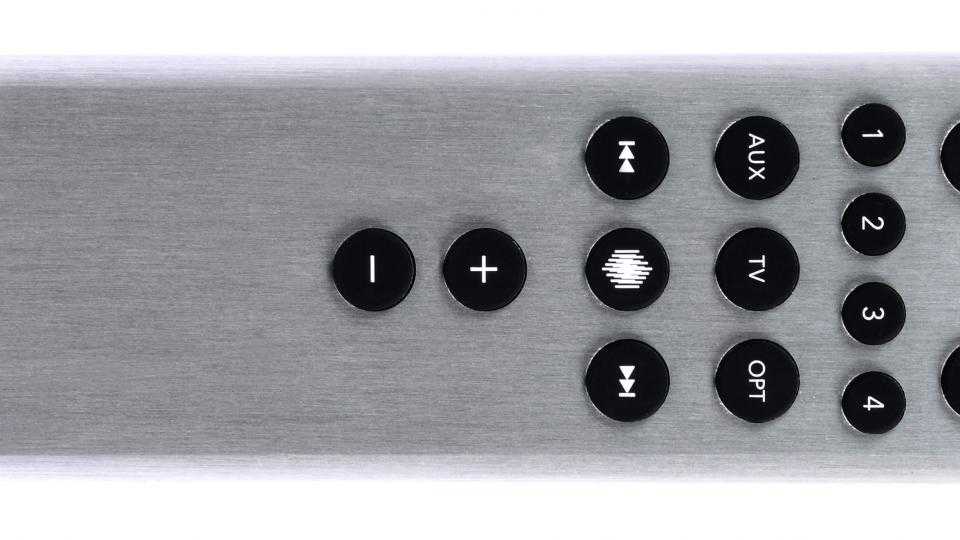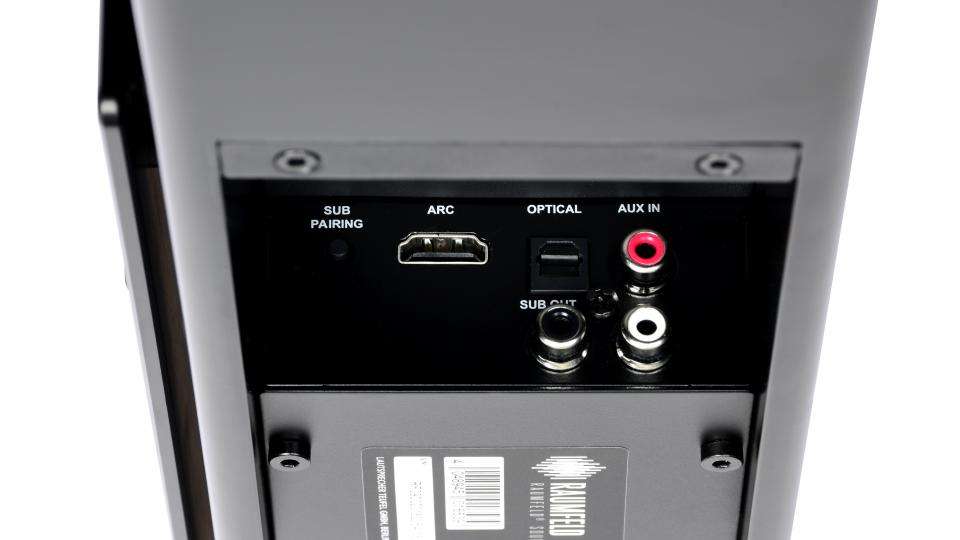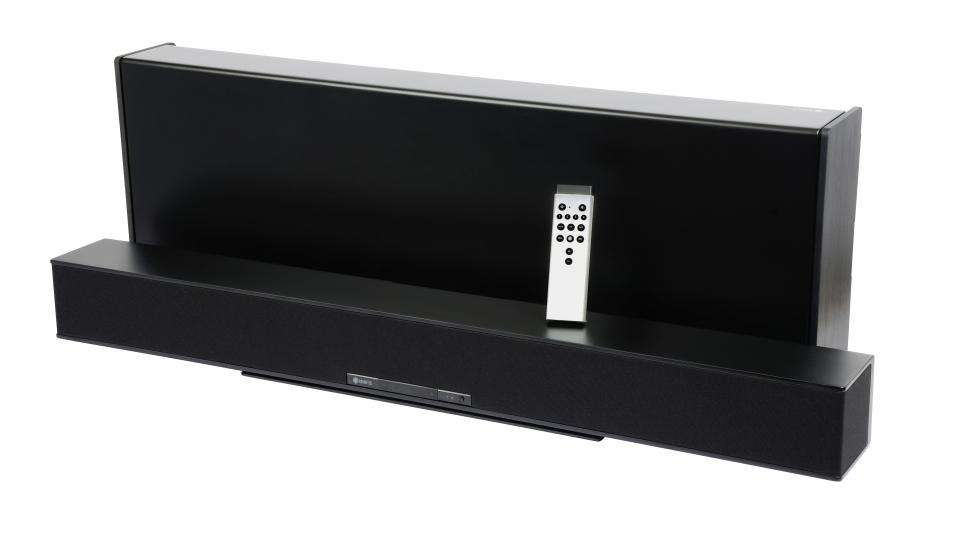Raumfeld’s Soundbar is designed to fit into its multiroom system in a similar way to Sonos’ Playbar , providing both a TV audio upgrade as well as a way to access internet and network streamed audio. It’s certainly one of the pricier soundbars on paper, as the LG MusicFlow HS9 is considerably cheaper, but considering it comes with a wireless active subwoofer as standard, it does compare well against its Sonos rival.
One slight advantage the Soundbar has over the Sonos Playbar is the inclusion of an HDMI ARC output, allowing you to control it using your TV remote. Alternatively, you can also connect it to your TV using an optical digital cable (albeit without the ability to control it via your TV remote), and you can also connect another source over the RCA phono connection. Unlike the LG MusicFlow HS9, there isn’t any Bluetooth, so you won't be able to use it to play music from your phone or tablet, but this has been an ongoing omission from Sonos’ speakers as well.
The design of the Raumfeld Soundbar matches the rest of its multiroom speakers, and uses a speaker cloth that extends the full length of the soundbar. It's available in either a white or black finish, but it's worth noting that its overall dimensions are quite sizable. Measuring 990x110x113mm when attached to its pre-assembled base, the Soundbar is very tall compared to its competitors, and can easily obscure your TV's IR receiver. This is less of a problem for wall-mounted TVs, but those who have their TV placed on a table or stand will need to check it has enough clearance to fit underneath, particularly since Raumfeld hasn't included an IR Blaster to help alleviate this problem. It does include wall brackets to mount the Soundbar to your wall, but keep in mind it weighs a substantial 8.6kg.
A large rectangular wireless active subwoofer is also included and has a similar metal finish to the main soundbar unit. It’s designed to either lie flat or stand upright vertically along its long edge so you can place it against a wall, but when it measures 955x330x120mm, you might be hard pressed to fit it into a cabinet or underneath your sofa.

The only physical controls on the Soundbar are volume and power buttons. Two status LEDs are also included, which indicate whether the Soundbar has power and whether it's connected to your network, but otherwise it's impossible to tell which source the Soundbar is currently set to.
Instead, you'll have to use the included metal remote to change sources, as this is the only way you can switch between the auxiliary, HDMI ARC and optical connections. The remote also has four preset buttons that are available on many Raumfeld speakers, and these let you access any preset profiles you've saved in the Raumfeld app, such as albums or playlists. Bear in mind, though, that the remote control doesn’t come paired with the Soundbar, so you'll have to go through the tedious process of pairing them manually, which only worked successfully after multiple failed attempts.

To set up the Soundbar, you'll need to download the Raumfeld Controller app, which is available for both iOS and Android devices. You can also use the app to connect the Soundbar to your home network, which thankfully is much simpler than trying to pair the Soundbar with the remote. We had the Soundbar up and running within minutes of opening the app, and once connected, you can use the app to download any software updates as well. Alternatively, you can use the Ethernet port on the back of the Soundbar for a wired connection if you prefer.
The app also lets you group and control other Raumfeld speakers in concert with the Soundbar, allowing you to play music from services including Spotify (through Spotify Connect), Tidal and TuneIn Radio, as well as from networked computers and storage simultaneously in different rooms. You even get basic EQ controls for the soundbar, allowing you to adjust the bass and treble.
If you want to adjust the subwoofer, you’ll have to use its rear physical controls. These include adjusting the high pass frequency, phase reverse and sensitivity for best bass performance. In testing, I found I had to reverse the phase 180 degrees to get the best sound, but you'll probably want to experiment with it yourself to find what's right for you.
When watching films, there was good stereo separation and the subwoofer's incredible bass really made sound effects feel real and tangible. The sound stage was wider than most soundbars, too, delivering clear dialogue with a proper centre channel. There are also Arena, Theatre and Voice sound modes that change the profile of the sound. Arena and Theatre modes create an even wider, more immersive soundstage using the side-firing speakers, whereas Voice emphasises the centre channel for dialogue.
The Soundbar performed best with music, however. With its six 70mm full-range drivers, the Soundbar was able to deliver an incredibly crisp, wide sound that was dispersed around the room. The subwoofer's three additional high-excursion drivers also produced some of the deepest bass I've heard. In fact, it can still be felt across the room, even when it's toned down as far as it can go, so the Soundbar might not be the best choice for those with easily disturbed neighbours. Sadly, there’s no night mode to help dampen the sound.

The Raumfeld Soundbar is without doubt a great soundbar and subwoofer combination, but with its superior music playback makes it feel more like one of Raumfeld’s multiroom speakers than a dedicated TV soundbar. It’s also very expensive and overly-large. Admittedly, the Sonos Playbar will cost more when you add in the cost of a subwoofer, but it does give you the option of adding rear speakers to create a 3.1 or 5.1 audio system. Raumfeld's Soundbar, on the other hand, can only be used as an additional multiroom speaker.
As a result, it's hard to recommend the Soundbar as a good starting point for improving your TV's audio unless you already have an existing Raumfeld multiroom ecosystem in place. At this price, the Sonos’ Playbar or LG’s MusicFlow HS9 provide a better foundation and give you more options for expansion at a later date.
|
Hardware |
|
Speakers |
6 |
|
RMS power output |
200W |
|
Subwoofer option |
240W (included) |
|
Rear speaker option |
N/A |
|
Dimensions |
990x110x100mm |
|
Weight |
8.6kg |
|
Ports |
|
Audio inputs |
HDMI ARC, Optical S/PDIF, RCA |
|
Audio outputs |
None |
|
Video inputs |
HDMI 1.4 |
|
Video outputs |
HDMI 1.4 |
|
Dock connector |
None |
|
USB port |
1 |
|
Networking |
802.11n |
|
NFC |
No |
|
Features |
|
Video playback formats |
N/A |
|
Image viewing formats |
N/A |
|
Audio playback formats |
N/A |
|
Smart TV apps |
Spotify Connect, Soundcloud |
|
Buying information |
|
Price including VAT |
£930 |
|
Warranty |
One year RTB |
|
Details |
www.raumfeld.com |
|
Part code |
Raumfeld Soundbar |

